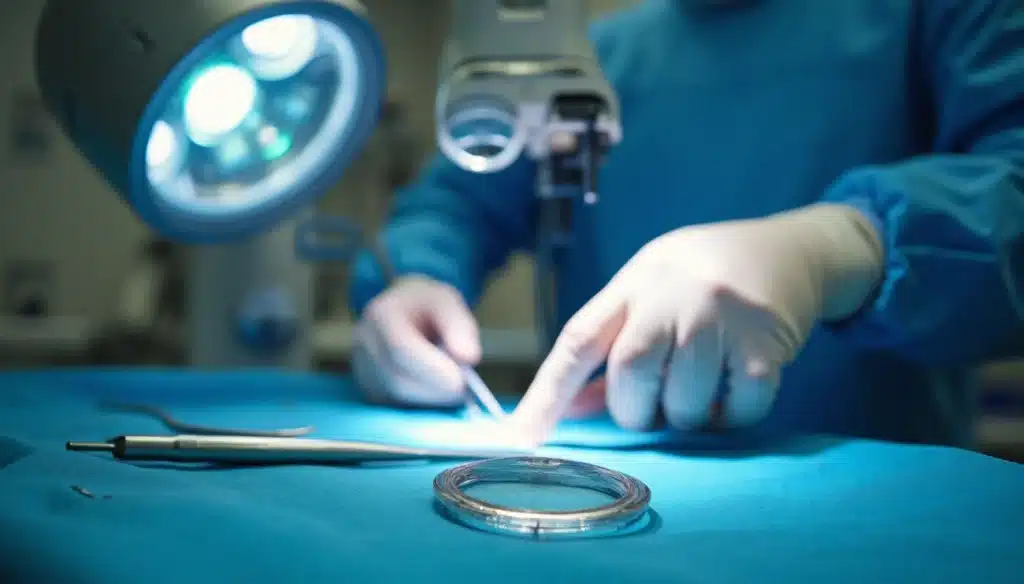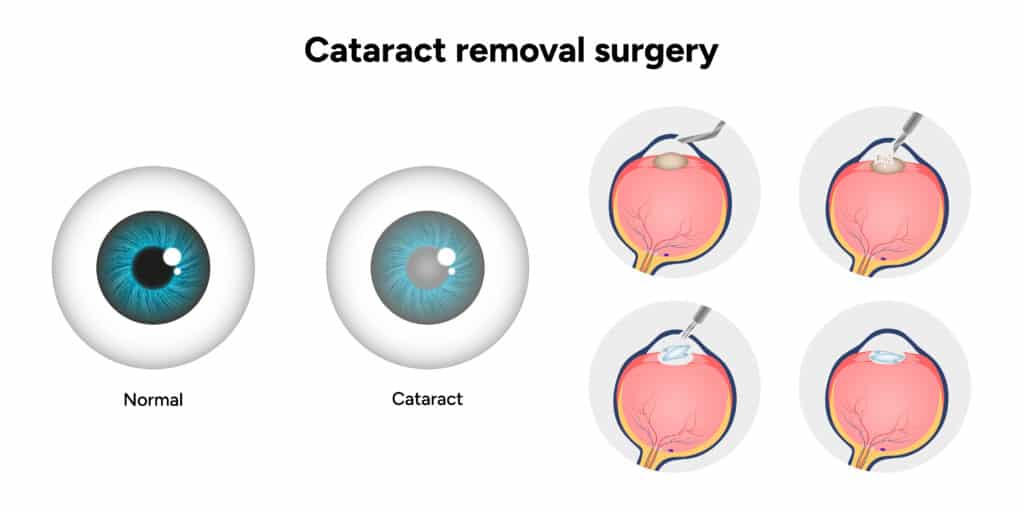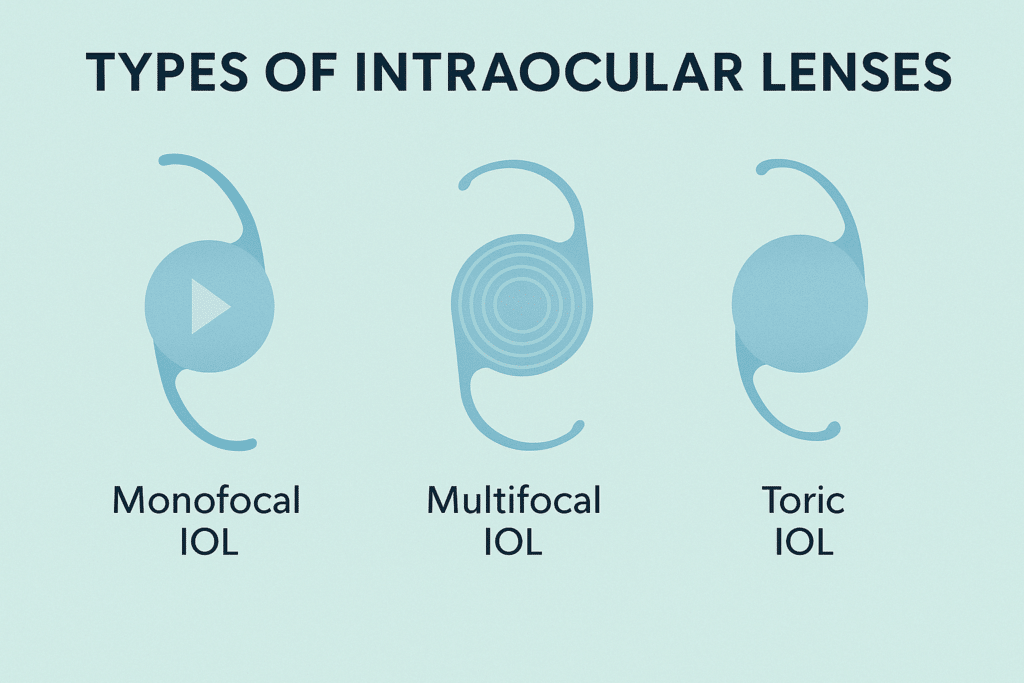Want to know about the 3 types of cataract surgery you can choose from? UK cataract procedures have a remarkable 99.6% success rate, which makes your path to clear vision more reassuring.
Modern cataract eye surgery has improved by a lot and now gives you three different approaches based on the type of intraocular lens (IOL). The NHS covers monofocal lens surgery, which stands as the most common choice and delivers excellent distance vision. On top of that, multifocal lens surgery lets you see clearly at multiple distances. Patients with astigmatism can benefit from toric lens surgery, which targets their specific condition. Your chances of getting useful vision back are excellent – over 90% of cataract operations succeed with very few complications.
Our team at Precision Vision London helps you pick the right cataract surgery type that matches your lifestyle, visual needs, and budget. Advanced technology and expert surgeons work together to give you personalised care. This piece shows you what each option means so you can make the best choice for your eye health.

Monofocal Lens Surgery
Monofocal lens implants stand as the gold standard for cataract surgery in 2025. These implants give patients reliable vision correction with a proven track record of success. You should think about monofocal lenses if you’re planning to address cataracts, as they’re the most popular choice among the three types of cataract surgery.
Monofocal Lens Surgery key features
Monofocal lenses have a single focusing power that gives clear vision at one specific distance—typically far, intermediate, or near. Most patients choose these lenses for distance vision, which works great for activities like driving or watching television.
These 50-year old intraocular lenses (IOLs) have evolved into exceptionally well-manufactured, high-quality implants with remarkable reliability. Your eye’s cloudy natural lens gets replaced with these lenses during cataract surgery, which fixes aphakia—the absence of the eye’s crystalline lens.
Monofocal lenses come in various materials, including:
- Polymethyl methacrylate (PMMA) – rigid lenses
- Silicone – foldable lenses
- Hydrophobic acrylic – foldable lenses
- Hydrophilic acrylic – foldable lenses
The lens’s central part, called the optic, measures between 5.25 mm and 6.5 mm. The total length with peripheral supports (haptics) spans 12 to 13.5 mm. This precise engineering makes sure the lens stays stable in your eye. Monovision offers an interesting option if you want improved range of vision. This technique puts monofocal lenses with different focusing powers in each eye—one for distance vision and another for near vision. Your brain adapts to handle these different visual inputs at once, which might reduce your need for reading glasses.
Recent breakthroughs have brought us “Premium Monofocal-Plus IOLs.” These lenses improve your range of far and mid-distance vision while keeping the benefits of traditional monofocal lenses. Our surgeons at Precision Vision London will help you decide if these advanced options suit your visual needs better.

Multifocal Lens Surgery
Multifocal lenses bring a breakthrough approach among the 3 types of cataract surgery. They let you see at multiple distances without glasses. This premium option marks a key advancement in cataract eye surgery technology. It gives more visual freedom to the right candidates.
Multifocal Lens Surgery key features
Multifocal intraocular lenses (IOLs) use sophisticated optical designs to create several focal points at once. Unlike monofocal lenses that focus at just one distance, multifocal IOLs help you see clearly at various ranges—near, intermediate, and far—after cataract surgery.
These advanced lenses work through:
- Refractive design: Uses concentric rings of varying thickness with different optical powers. Your eye can focus images from multiple distances onto the retina.
- Diffractive design: Uses diffractive microstructures in concentric zones that get closer toward the lens periphery. This design gives excellent distance and near vision.
- Combined design: Uses both refractive and diffractive elements to boost visual range at all distances.
Your brain naturally picks the right focal point based on what you’re looking at after implantation. This happens automatically, similar to bifocal or multifocal eyeglasses, but with a natural experience across your entire visual field.
Most patients need time to adjust as their visual system adapts to the new lenses. Visual effects like halos usually fade or disappear over time. Our expert surgeons at Precision Vision London monitor this adaptation process and give personalised guidance throughout your recovery. The latest designs in multifocal technology create one elongated focal point instead of separate ones. This aims to give a more natural visual experience with fewer side effects. Studies on these newest designs continue.
Multifocal Lens Surgery pros and cons
| Advantages | Disadvantages |
|---|---|
| Less need for glasses: You likely won't need glasses for most activities. About 95% of patients stop using glasses after getting multifocal lens implants. | Light effects: About 5-10% of patients see halos or glare around lights, mainly at night. Most people adjust as their brain learns to process the visual information better. |
| Vision at all distances: These lenses correct vision at multiple distances. You can switch naturally between reading, computer work, and driving without changing glasses. | Less contrast: Reading in dim light might be harder due to reduced contrast sensitivity. This varies by patient and lens design. |
| Great results: Studies show multifocal IOLs give binocular uncorrected vision of 0.30 logMAR or better in 100% of patients for distance, 96% for intermediate, and 97.3% for near vision. | Time to adjust: Your brain needs time to process multiple focal points. This might affect your vision quality temporarily. |
| Save money long-term: Though they cost more upfront, multifocal lenses can cut lifetime spending on glasses, contacts, and prescription changes. | Not for everyone: These lenses might not work well if you have macular degeneration, glaucoma, severe dry eye, or irregular astigmatism. |
| Better lifestyle: Many patients enjoy a better quality of life. They can see clearly at various distances without juggling multiple pairs of glasses. | Higher cost: Multifocal lenses cost more than standard monofocal lenses. The NHS doesn't usually cover these extra costs. |
Our team at Precision Vision London runs thorough pre-operative tests to spot potential issues before recommending multifocal lenses. This ensures you get the best solution for your vision needs.

Toric Lens Surgery
Toric lens surgery stands as the third major type of cataract surgery. It tackles both cataracts and astigmatism at once. Almost one-third of cataract patients have substantial astigmatism, and this specialised option gives them clearer vision without extra procedures.
Toric Lens Surgery key features
Toric intraocular lenses (IOLs) have a unique asymmetrical design that separates them from standard lenses. Standard spherical lenses have uniform curvature. Toric lenses work differently – they have varying powers in different meridians. This design corrects the irregular corneal shape that causes astigmatism.
These lenses have distinctive characteristics:
- A special weighted design keeps the lens properly oriented in the eye
- The lens needs precise alignment with your astigmatism’s unique axis
- You can choose from monofocal and multifocal variations based on your visual needs
- The lens corrects astigmatism from 0.75 diopters up to 6.0 diopters
The surgical method matches standard cataract surgery, but lens alignment is vital. Your surgeon runs extra tests before the procedure. These tests determine the right toric power and orientation specific to your eye’s astigmatism. Special markings guide your surgeon during the operation. These marks ensure correct lens alignment along your eye’s astigmatic axis. Perfect positioning matters greatly. Even slight misalignments can reduce how well the lens works. Your follow-up visits help ensure the lens stays aligned properly while you heal.
Our surgeons at Precision Vision London use cutting-edge imaging techniques and reference marks. This approach maximises visual results for patients with astigmatism.
Toric Lens Surgery pros and cons
| Advantages | Disadvantages |
|---|---|
| Complete correction: You get both cataract and astigmatism fixed in one surgery. No extra procedures or special eyewear needed for astigmatism | Alignment risks: These lenses must sit perfectly. A 10-degree misalignment substantially reduces effectiveness and might need fixing |
| High success rate: Research shows exceptional results. 98% of patients end up with 0.75 diopters or less of leftover astigmatism | Higher cost: Toric IOLs cost more than standard options. Insurance and NHS usually don't cover the extra expense |
| Less need for glasses: Patients who need distance glasses dropped from 40% before surgery to 19.4% after toric IOL implantation | Limited eligibility: The surgery isn't right for everyone. Irregular astigmatism, unstable zonules, or certain eye conditions might rule it out |
| Better visual quality: Vision becomes sharper and more stable by fixing astigmatism-caused distortions | Some remaining astigmatism: A small amount might stay uncorrected. Some patients still need glasses for perfect vision |
| Permanent fix: The astigmatism correction lasts forever. No ongoing maintenance like glasses or contacts require | Longer wait times: Custom lenses take time. Your specific lens needs ordering before surgery |
Pricing in the UK for Toric Lens Surgery
Toric lens surgery costs more than basic monofocal options. The price reflects specialised technology and surgical precision. UK prices range from £3,350 to £5,000 per eye.
Current UK provider pricing looks like this:
| Lens Type | Price Range (Per Eye) |
|---|---|
| Monofocal Toric IOL | £3,350 - £4,500 |
| Trifocal/Multifocal Toric IOL | £4,350 - £5,000 |
Your final cost depends on:
- Which toric lens you pick
- Your choice between monofocal or multifocal toric options
- Your chosen clinic’s location and reputation
- Your surgeon’s toric lens experience
- Any extra procedures needed
Precision Vision London provides clear pricing and detailed cost breakdowns. We offer payment plans that make this advanced technology available. The NHS typically covers only basic monofocal lenses. Many patients find great value in this investment. They save money on prescription glasses, contact lenses, and solutions over many years.
Comparison Table
| Attribute | Monofocal Lens Surgery | Multifocal Lens Surgery | Toric Lens Surgery |
|---|---|---|---|
| Description | Standard lens with single focusing power | Advanced lens that enables vision at multiple distances | Specialised lens that corrects both cataracts and astigmatism |
| Key Features | - Single focal point (typically distance)\n- Available in various materials\n- Option for monovision approach | - Multiple focal points (near, intermediate, far)\n- Uses refractive or diffractive design\n- Your brain automatically selects focal points | - Asymmetrical design\n- Weighted to maintain orientation\n- Corrects astigmatism 0.75-6.0 diopters |
| Cost Range (per eye) | £1,995 - £3,150 | £3,195 - £4,750 | £3,350 - £5,000 |
| Benefits | - Most affordable option\n- Clear vision quality\n- 20+ years safety record\n- Minimal visual disturbances | - Less reliance on glasses\n- Clear vision at multiple distances\n- 95% freedom from glasses\n- Better quality of life | - Fixes astigmatism and cataracts in one procedure\n- 98% success rate\n- Reduced need for glasses\n- Permanent astigmatism correction |
| Limitations | - Focus at one distance only\n- Reading glasses needed\n- Limited astigmatism correction | - You might see halos/glare\n- Lower contrast sensitivity\n- Takes time to adjust\n- Costs more | - Risk of lens moving out of place\n- Higher price point\n- Needs more preparation time\n- Some astigmatism might remain |
| Best Suited For | - People who prioritise distance vision\n- Budget-conscious patients\n- Those who drive at night\n- People comfortable using reading glasses | - People with active lifestyles\n- Those wanting freedom from glasses\n- Patients with healthy eyes | - People with regular corneal astigmatism\n- Those with stable eye health\n- Patients wanting fewer glasses\n- After corneal transplant cases |
Conclusion
Your unique visual needs, lifestyle priorities, and budget will determine the best cataract surgery type for you. We’ve looked at three main options available in 2025: monofocal, multifocal, and toric lens surgeries. Each option serves different patient needs differently. NHS covers monofocal lenses that provide crystal-clear vision at one distance. Multifocal options let you see clearly at various distances and reduce your dependence on glasses substantially. Toric lenses tackle both cataracts and astigmatism at once, which makes them perfect for patients with irregular corneal shapes.
British cataract procedures boast an impressive 99.6% success rate, thanks to better surgical techniques and lens technology. Your best choice depends on your specific situation. Your daily routine, vision priorities, current eye health, and financial capacity are vital factors that help determine the most suitable approach.
Our specialists at Precision Vision London use cutting-edge diagnostic technology to assess your eyes and vision needs before suggesting the right solution. This complete evaluation will give a treatment plan that fits your unique case. We also track your recovery closely and help you adapt, especially when you have premium lens options.
Better vision is an investment that will affect your life quality for years. Need help choosing the right cataract surgery option? Let our specialists at Precision Vision London walk you through your options with expert guidance. Book your consultation now to get personalised advice.
Modern cataract surgery opens new possibilities for patients who want clearer vision. While each option has its benefits and things to think over, the main goal stays the same – to restore your vision and boost your quality of life. Whatever type of cataract surgery you pick, taking action now is a big step toward staying independent and seeing the world more clearly.
Key Takeaways
Understanding your cataract surgery options empowers you to make an informed decision that aligns with your lifestyle, visual needs, and budget for optimal long-term outcomes.
- Monofocal lenses (£1,995-£3,150) offer excellent single-distance vision with NHS coverage, ideal for budget-conscious patients prioritising distance clarity
- Multifocal lenses (£3,195-£4,750) provide vision at multiple distances with 95% of patients achieving glasses independence for most activities
- Toric lenses (£3,350-£5,000) simultaneously correct cataracts and astigmatism with 98% success rate, perfect for patients with corneal irregularities
- Success rates are exceptional across all types, with UK cataract procedures achieving 99.6% success and over 90% restoring useful vision
- Lifestyle considerations matter most – active individuals benefit from multifocal options, whilst night drivers often prefer monofocal lenses for superior clarity
The key to optimal outcomes lies in thorough pre-operative assessment and realistic expectations. Each surgery type serves different patient profiles, making professional consultation essential for determining your ideal solution among these proven cataract treatment options.
FAQs
Q1. What are the main types of cataract surgery available in 2025? The three primary types of cataract surgery in 2025 are monofocal lens surgery, multifocal lens surgery, and toric lens surgery. Each type uses different intraocular lenses (IOLs) to address specific visual needs and conditions.
Q2. How do the costs of different cataract surgery options compare? Monofocal lens surgery is typically the most affordable, ranging from £1,995 to £3,150 per eye. Multifocal lens surgery costs between £3,195 and £4,750 per eye, while toric lens surgery ranges from £3,350 to £5,000 per eye. Prices may vary based on the clinic and specific lens technology used.
Q3. What is the success rate for cataract surgery in the UK? Cataract surgery in the UK has an impressive success rate of 99.6%. Over 90% of procedures successfully restore useful vision, with remarkably low complication rates.
Q4. Who is best suited for multifocal lens surgery? Multifocal lens surgery is ideal for active individuals seeking reduced dependence on glasses for various distances. It’s best suited for those with healthy eyes, realistic expectations, and the willingness to adapt to a new visual experience.
Q5. Can toric lenses correct both cataracts and astigmatism? Yes, toric lenses are specifically designed to address both cataracts and astigmatism simultaneously. They are most effective for patients with regular corneal astigmatism of 0.75 diopters or greater, offering a comprehensive solution in a single procedure.
Authors & Reviewer
-
 Olivia: Author
Olivia: AuthorHi, I'm Olivia, a passionate writer specialising in eye care, vision health, and the latest advancements in optometry. I strive to craft informative and engaging articles that help readers make informed decisions about their eye health. With a keen eye for detail and a commitment to delivering accurate, research-backed content, I aim to educate and inspire through every piece I write.
-
 Dr. CT Pillai: Reviewer
Dr. CT Pillai: ReviewerDr. CT Pillai is a globally recognised ophthalmologist with over 30 years of experience, specialising in refractive surgery and general ophthalmology. Renowned for performing over 50,000 successful laser procedures.

